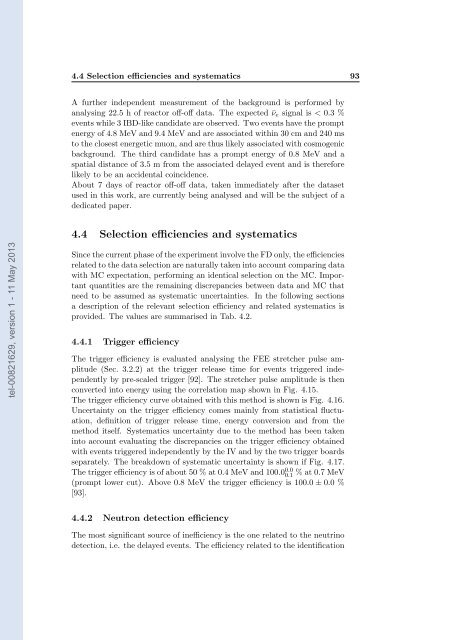Etude et impact du bruit de fond corrélé pour la mesure de l'angle ...
Etude et impact du bruit de fond corrélé pour la mesure de l'angle ...
Etude et impact du bruit de fond corrélé pour la mesure de l'angle ...
Create successful ePaper yourself
Turn your PDF publications into a flip-book with our unique Google optimized e-Paper software.
4.4 Selection e ciencies and systematics 93<br />
A further in<strong>de</strong>pen<strong>de</strong>nt measurement of the background is performed by<br />
analysing 22.5 h of reactor o↵-o↵ data. The expected ¯⌫ e signal is < 0.3 %<br />
events while 3 IBD-like candidate are observed. Two events have the prompt<br />
energy of 4.8 MeV and 9.4 MeV and are associated within 30 cm and 240 ms<br />
to the closest energ<strong>et</strong>ic muon, and are thus likely associated with cosmogenic<br />
background. The third candidate has a prompt energy of 0.8 MeV and a<br />
spatial distance of 3.5 m from the associated <strong>de</strong><strong>la</strong>yed event and is therefore<br />
likely to be an acci<strong>de</strong>ntal coinci<strong>de</strong>nce.<br />
About 7 days of reactor o↵-o↵ data, taken immediately after the datas<strong>et</strong><br />
used in this work, are currently being analysed and will be the subject of a<br />
<strong>de</strong>dicated paper.<br />
4.4 Selection e ciencies and systematics<br />
tel-00821629, version 1 - 11 May 2013<br />
Since the current phase of the experiment involve the FD only, the e ciencies<br />
re<strong>la</strong>ted to the data selection are naturally taken into account comparing data<br />
with MC expectation, performing an i<strong>de</strong>ntical selection on the MC. Important<br />
quantities are the remaining discrepancies b<strong>et</strong>ween data and MC that<br />
need to be assumed as systematic uncertainties. In the following sections<br />
a <strong>de</strong>scription of the relevant selection e ciency and re<strong>la</strong>ted systematics is<br />
provi<strong>de</strong>d. The values are summarised in Tab. 4.2.<br />
4.4.1 Trigger e ciency<br />
The trigger e ciency is evaluated analysing the FEE str<strong>et</strong>cher pulse amplitu<strong>de</strong><br />
(Sec. 3.2.2) at the trigger release time for events triggered in<strong>de</strong>pen<strong>de</strong>ntly<br />
by pre-scaled trigger [92]. The str<strong>et</strong>cher pulse amplitu<strong>de</strong> is then<br />
converted into energy using the corre<strong>la</strong>tion map shown in Fig. 4.15.<br />
The trigger e ciency curve obtained with this m<strong>et</strong>hod is shown is Fig. 4.16.<br />
Uncertainty on the trigger e ciency comes mainly from statistical fluctuation,<br />
<strong>de</strong>finition of trigger release time, energy conversion and from the<br />
m<strong>et</strong>hod itself. Systematics uncertainty <strong>du</strong>e to the m<strong>et</strong>hod has been taken<br />
into account evaluating the discrepancies on the trigger e ciency obtained<br />
with events triggered in<strong>de</strong>pen<strong>de</strong>ntly by the IV and by the two trigger boards<br />
separately. The breakdown of systematic uncertainty is shown if Fig. 4.17.<br />
The trigger e ciency is of about 50 % at 0.4 MeV and 100.0 0.0<br />
0.1 % at 0.7 MeV<br />
(prompt lower cut). Above 0.8 MeV the trigger e ciency is 100.0 ± 0.0 %<br />
[93].<br />
4.4.2 Neutron d<strong>et</strong>ection e ciency<br />
The most significant source of ine ciency is the one re<strong>la</strong>ted to the neutrino<br />
d<strong>et</strong>ection, i.e. the <strong>de</strong><strong>la</strong>yed events. The e ciency re<strong>la</strong>ted to the i<strong>de</strong>ntification





![[tel-00726959, v1] Caractériser le milieu interstellaire ... - HAL - INRIA](https://img.yumpu.com/50564350/1/184x260/tel-00726959-v1-caractacriser-le-milieu-interstellaire-hal-inria.jpg?quality=85)










